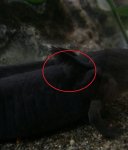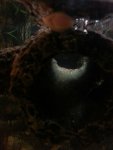cherryglue
New member
So about 4 days ago he had just a tiny bit almost not even visible...he had it before and we thought it was an infection and treated it and it went away, this time it seems to be back with a vengeance lol.
Someone told me its probably just gunk from his tank, but its getting worse each day. Our parameters are still basic (fresh tank) 0 ammonia, 0 nitrite / nitrate, 7 ph. It doesnt make sense to me that it would get worse because he doesnt brush up against his floating log, which has a TON of similar gunk on it. There is a bit of it on two of his live plants but not as much as would cause that much on his gills.
however, we currently have his carbon filter out because we have medicine in the tank, so maybe if we put the filter back in it will help it go away, idk. He doesnt seem sick or anything, so this doesnt feel right in the sick thread, he's just not as active as normal but we think thats just because his new tank is HUGE. (he's about 5 inches in a 4ft long 55gallon tank)
Anyway, the first image is his gills, you cant see it but its on both his right AND left top most gills and used to only be on his left top gill.
The second image is one i found on google that is dangerously close to what his looks like, just not as thick.
The last few pictures are his log because it looks like the same stuff as whats on his gills..
Any tips on getting rid of this junk would be awesome, we are going to put his carbon filter back in soon and use some API Stress Zyme in hopes it will eat away the gunk.
Someone told me its probably just gunk from his tank, but its getting worse each day. Our parameters are still basic (fresh tank) 0 ammonia, 0 nitrite / nitrate, 7 ph. It doesnt make sense to me that it would get worse because he doesnt brush up against his floating log, which has a TON of similar gunk on it. There is a bit of it on two of his live plants but not as much as would cause that much on his gills.
however, we currently have his carbon filter out because we have medicine in the tank, so maybe if we put the filter back in it will help it go away, idk. He doesnt seem sick or anything, so this doesnt feel right in the sick thread, he's just not as active as normal but we think thats just because his new tank is HUGE. (he's about 5 inches in a 4ft long 55gallon tank)
Anyway, the first image is his gills, you cant see it but its on both his right AND left top most gills and used to only be on his left top gill.
The second image is one i found on google that is dangerously close to what his looks like, just not as thick.
The last few pictures are his log because it looks like the same stuff as whats on his gills..
Any tips on getting rid of this junk would be awesome, we are going to put his carbon filter back in soon and use some API Stress Zyme in hopes it will eat away the gunk.





